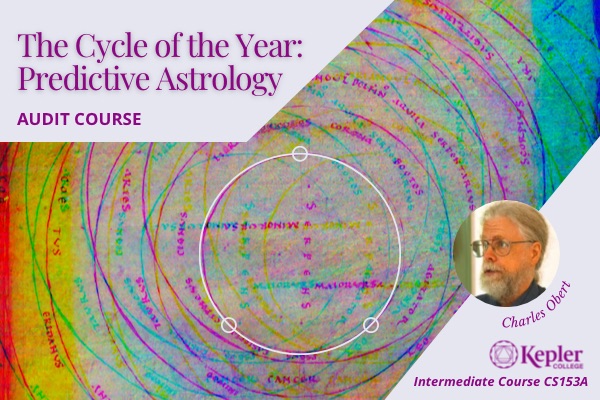
Course description:
Traditional astrology offers a particularly effective system of forecasting that combines techniques to help you prepare for the future and understand the past.
This system is known as the Cycle or Turning of the Year. Instead of just using a Solar Return, this method was prepared yearly for each birthday. It has its roots in Hellenistic astrology, came to full flower in the Arabic and Persian eras, and persisted through the late Classical period of Lilly and his contemporaries. Ben Dykes' translation of Abu Mashar's On Solar Revolutions in Persian Nativities3 is a full exposition of this system.
This course covers the three techniques involved in this system:
- distribution through the bounds or terms (aka primary direction)
- profections
- solar returns
Required books can be found under the Electives-Classical section of https://keplercollege.org/index.php/required-books-for-courses
Using clear explanations, examples, and exercises, Charlie shows students how to apply each technique individually and then practice putting them all together. Students will then practice using them in combination with traditional techniques for evaluating a chart.
Required Books:
The Cycle of the Year: Traditional Predictive Astrology Charles Obert: Found through StudentofAstrology.com for pdf or physical copy.
Pre-requisite: fundamentals or equivalent.
Segment topics:
- Introduction and Solar Returns
- Profections
- Direction Through the Bounds
- Using the Techniques Together
- Fixed Stars, Lunar Mansions, and the Guardian Daimon
Instructor bio:
Charlie Obert is a student of astrology since high school and has studied and practiced both modern and traditional astrology techniques. He teaches workshops and leads study groups on traditional astrology. Charlie is the author of An Introduction to Traditional Natal Astrology and Using Dignities in Astrology, which are currently being used as textbooks at Kepler College. His teachers included Dr. Benjamin Dykes and Chris Brennan.
Charlie's current focus is working on how traditional and modern astrologers can complement and learn from each other. He has a twice-monthly blog on astrology topics on his website at https://studentofastrology.com.

This course was recorded in 2024.
Instructor: Cornelia Hansen
Using an astrological chart to determine an individual's psychological temperament has ancient origins. This course applies that knowledge to better understand children. This course is a new approach to looking at temperament using modern child development concepts. The analysis learned in this course can also be used for adult charts and is especially useful for work on compatibility or couple's counseling.
Applying astrological and modern child development concepts of temperament, this course provides students with a new approach to looking at
• How analyzing and interpreting a child's chart differs from an adult's,
• Identifying temperamental "types" and their characteristics,
• Identifying parenting strategies that can more effectively meet a child's individual needs
• The lifelong influences and effects of temperament on behavior
• How an astrologer can counsel parents in a way that promotes positive developmental progress.
• Possible uses of temperament information in making comparisons among both children and adults, plus applications for couple’s counseling
This course is designed to help the astrologer to understand where there is or is not a good fit between the child and his/her physical and social environment and what that entails.
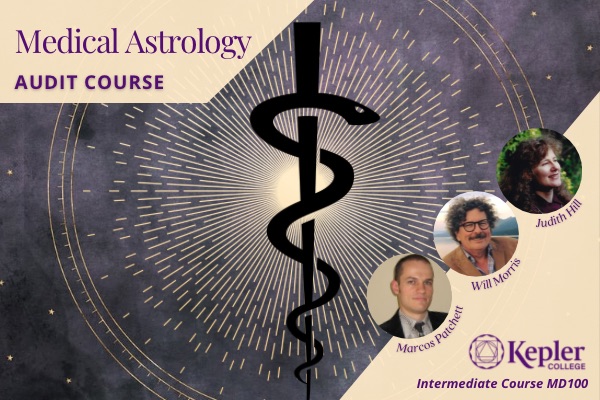
This course was recorded in 2022.
Course description:
This course is designed to be an historically inclusive, in-depth and practical introduction to medical astrology. Students will be introduced to historical practitioners and core concepts in astrological medicine from its ancient Greek beginnings through our modern period. By the end of the course, students will have an overview of the development of medical astrology and its potential applications, as well as the legal, ethical and philosophical principles informing its use.
The course will equip students with the techniques to hold a medical astrological evaluation (within the bounds of their own medical knowledge, legal permissions and personal competence). These procedures will include the medical assessment of birth charts, consultation charts and decumbitures, transits, profections and solar returns for the purposes of understanding medical concerns from astrological perspectives. The course covers traditional concepts of Temperament from both Elemental and Humoral frameworks and will enable students to utilize astrology to help clients dealing with medical issues in practical and responsible ways.
This Medical Astrology course is intended for general informational and historic purposes only, and does not constitute medical diagnosis, opinion, fact, directives or advice. Individuals should always seek their physician’s approval before considering any ideas, hypotheses or ancient knowledge imparted by the teachers of MD100. Any application of the information set forth in this course is at the student's discretion and is his or her sole responsibility.Kepler College and the course teachers of MD100 are not responsible for student misuse or medical use (for self or others, including clients, family, and friends) of course material and information.
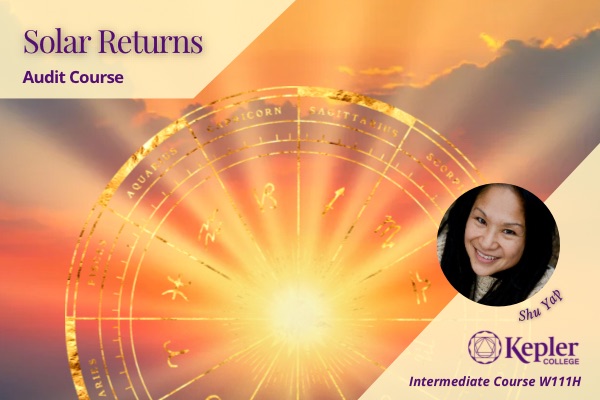
This course was recorded in 2023.
Solar Returns or Revolutions is a forecasting technique that’s based on a chart cast at the moment where the Sun returns to its natal position at any year of inquiry. This predictive method has been used for centuries and over this time, many interpretive techniques have evolved out of this system.
Solar Returns is appealing because it neatly encapsulates a 12-month perspective into one chart, in relation to a natal chart. As it also draws from the same fundamental principles of natal chart analysis, Solar Returns is great way to extend and build on your existing skills in natal astrology.
In this 5-segment short course, we will explore some fundamental principles behind Solar Return charts to help you build some skills to start working with them in your study and practice. Many of the core principles used in natal chart analysis are also used within the Solar Returns system, but some adjustments are required to reframe these principles within the context of a one-year time slice. Foundational skills in natal astrology are required.
Over the 5 segments, we will cover topics such as:
The historical evolution of the Solar Returns technique
Basic Solar Return interpretive chart principles,
Comparing natal chart signatures to the Solar Returns chart
Combining Annual Profections
Analysing Solar Return charts over multiple years
Tracking the Solar Return chart over the current year
Formulating a judgement about the Solar Returns chart
The outcome is that students will be able to look at any Solar Returns chart and draw out some significant themes for the year based on the techniques delivered during this course.
Chart examples, reading resources and quizzes will be provided, and students are encouraged to work on their own Solar Returns chart during the course.
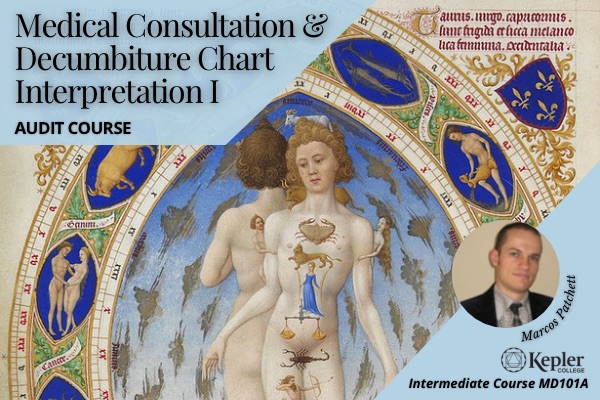
This course was recorded in 2023
~~~~~~~~~~~~~~~~~~~~~~~~~
This course is the first half of a module teaching the traditional art of decumbiture and medical consultation chart interpretation. Students will be introduced to many of the principal figures in the Renaissance astrological tradition and their work. The course covers key differences and similarities between consultation charts, decumbiture, and horary charts. Ethical and practical limitations of astrological prognosis will be discussed; techniques will include the use of reception, crisis charts, and horary predictive techniques in defining astrological prognosis, in addition to general remediation or counsel which may be adduced from the astrological chart.
Prerequisites for the student taking this course: students should have astrological knowledge of signs, houses, planets, transits, and progressions. A basic understanding of key traditional concepts such as planetary dignities, sect, and reception are also essential.
Set texts / required reading:
1. Culpeper, N. (1655; repub. 2003). Astrological Judgment of Diseases from the Decumbiture of the Sick. Astrology Classics, U.S.A.
2. Masha’allah (8th century; repub. 1998). On Reception. [ed. & trans. Hand, R.] Archive for the Retrieval of Historical Astrological Texts, U.S.A.
Segment-by-segment:
1. Uses of decumbiture, consultation charts, and medical horary. Includes historical examples, similarities and differences, ethics and limitations, and an overview/exemplification.
2. Prognosis 1 – general prognosis. Reviews and expands material from MD100, including how to assess the general state of the chart e.g. hour ruler, aspects to the Sun and Moon; houses and their rulers, specifically the ascendant, the 6th and 8th houses, the 7th and 10th houses etc.
3. Prognosis 2 – specific prognosis. Reviews and expands material from MD100, including horary predictive techniques using the Ascendant ruler and the Moon, and Masha’allah’s Reception-based technique.
4. Prognosis 3 – Crisis Charts. Covers the use of Lunar and Solar medical crisis charts based on the decumbiture or consultation chart, and their use as transit charts to the nativity.
5. Remediation 1 – general recommendations. Describes the use of horary techniques such as planetary dignity and reception to help guide astrological counselling of clients dealing with medical issues.
This course equips students with the techniques to give an astrological prognosis and provide a framework for designing treatments or lifestyle interventions using consultation charts, horary charts and decumbitures, for the purpose of helping clients to obtain the best outcomes and navigate medical issues, and to help guide a therapist or treatment provider. The course covers traditional concepts of prognosis, in addition to discussing the limitations and ethical responsibilities of the practitioner; it will enable students to utilize astrology to help clients dealing with medical issues in practical and responsible ways.
At minimum, astrological knowledge of signs, houses, planets, transits, and progressions. A basic understanding of key traditional concepts such as planetary dignities, sect, and reception are also essential.
Prior completion of MD100 is preferable but not essential.
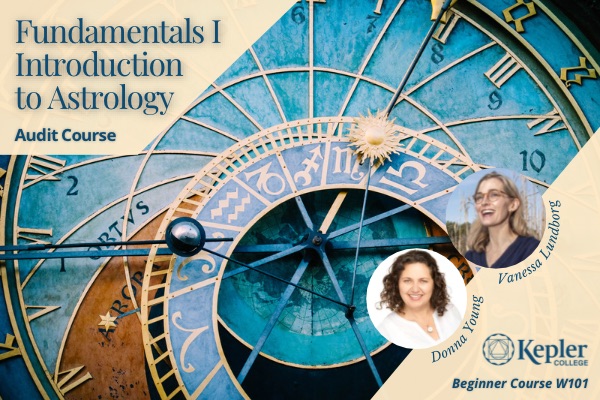
This course is pre-recorded - course description:
This course is designed for students who know the very basics of astrology and/or want to solidify the astrological knowledge they have already gained on their own. The astrological chart will be taken apart in order for students to clearly understand how each set of symbols functions and how their interaction provides the basis of interpretation. Students in this course will not only build a solid understanding of the basics of astrology but learn how to immediately apply what they learn to chart interpretation, even if there is no birth time.

This course is pre-recorded - course description:
Beyond basic interpretation of planets, signs, houses, and aspects, this course introduces students to techniques that clarify, or modify the chart interpretation to identify major life themes. Students learn the lineage of techniques and their modern practice, plus any controversy, to better understand the diversity of traditions in the 21st-century astrology community. The W102 course focuses on modifying the natal planet expression, taking interpretation from “cookbook” memorization to nuanced and personalized interpretation.
Topics covered include:
- Explore the range of philosophical purposes for natal chart interpretation
- Compare house systems to identify those suited for regular use from other more traditional or situation-specific.
- Explore how decans and dwads personalize planet sign and degree placement
- Interpret natal moon phases and lunar nodes to reveal areas of growth
- Examine the harmonic foundation of aspects with major and minor aspects
- Identify major life themes of planets in close aspect by longitude and declination, as well as in close aspect configurations
- Personalize interpretation with sensitive points such as Arabic parts, solstice points, decans and dwads, midpoints, Aries point, and the vertex.
- Explore how major asteroids, dwarf planets, and 8 notable fixed stars add interpretative detail
By the end of this course, students will have developed the skills necessary for evaluating chart information and identifying the strengths and weaknesses of different approaches. They will be able to synthesize the core astrological components and modify information into a coherent and meaningful interpretation without relying on outside resources.
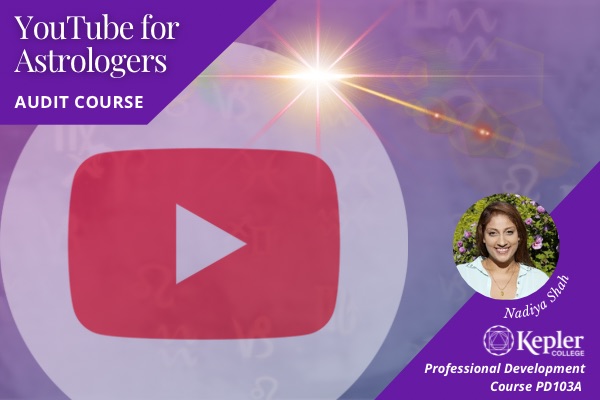
This course was recorded in 2023.
Course description:
YouTube for Astrologers
Youtube has been a revolutionary force for astrologers today. It provides a platform to reach others with your unique astrological voice, demonstrate your expertise, attract clients from around the world, and serves as a tool for many astrologers to be financially independent and self-supporting.
Video astrology is a skill of its own. This class is ideal if you are considering offering videos as part of your astrological practice, if you new to YouTube, or you want the support, ideas, and inspiration to reignite your established channel.
This class does assume you have some basic astrological knowledge, but registration is not limited only to astrologers. Anyone who is open to astrological insights and wants to bring a more conscious approach to developing a YouTube channel and creating a wholistic, spiritually integrated business, within a supportive environment, is welcome.
It is only the last half of the first class which specifically discusses astrological aspects of your own natal chart, as part of understanding the best strategies for you. Most of this course is practical, supportive, and a wonderful way to take your business to the next, most rewarding level for you.
An important part of this course is the mentorship offered by Nadiya. This is the only business course she teaches, only once a year, during which you will have access to her personal feedback and expertise, to help you as you uniquely might need, in her encouraging and positive style.
Learn more about your course instructor:
French Vanity Fair named Nadiya Shah one of the top 12 astrologers on the planet, crowning her a pioneer in video astrology. She is an Internationally Syndicated Astrologer, Author, Television and Internet Personality, and is also one of the few people in the world to hold an M.A. in the Cultural Study of Cosmology and Divination, from the University of Kent, United Kingdom.
Nadiya Shah is the author of several books, including The Body and The Cosmos, Prayers To The Sky, and The Universe is Wise & Loving, all of which debuted as #1 New Releases in New Age Astrology on Amazon. Her school Synchronicity University teaches astrology worldwide. At 161k+ subscribers, Nadiya’s wildly popular Youtube channel, nadiyashahdotcom is one of the most-watched Astrology channels in the world.
Find her online at nadiyashah.com
Nadiya teaches the following course:
PD103A YouTube for the Professional Astrologer
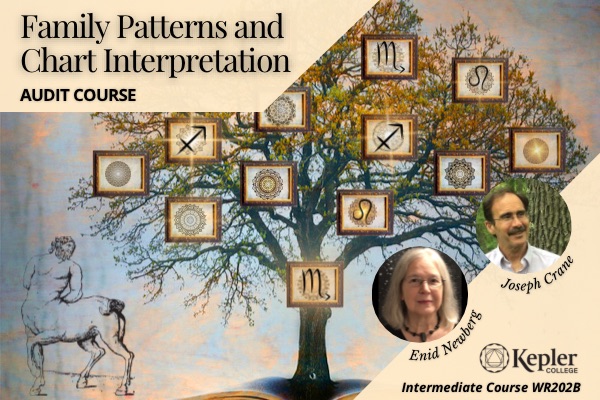
The course was recorded in 2023.
Course description: Students will continue to build their astrological interpretation skills as they examine issues related to families’ patterns, groups, and themes. Students will also continue to build their knowledge of psychological principles and ethical considerations.
This course offers practical guidance for astrologers working with their own and clients’ family issues: parents, children, siblings, or extended relationships.
Family relationships form much of the background complexity of a person’s life: they set patterns that manifest in relationships with bosses and subordinates, close friends and intimates, and in our career and lifestyle choices.
This course will go beyond the “nuclear family” to include a consideration of the social, ethnic, and historical contexts of family life. Students will sample psychodynamic approaches that inform much modern astrology and
systems approaches that enable an exploration of the interlocking patterns of our birth and family connections.
Students will examine parental/offspring and sibling relationships within family structures through the astrological chart. They will look at generational transmission, sibling position, and changes within the family to see how astrological indicators reflect these considerations and how they might run counter to them.
Participants are invited to share cases they have encountered in their work and to share insights from their own family experiences and their own lives.
Required Books: Recommended: not required.
-
McGoldrick, Gerson, Petry.
Genograms: Assessment and Intervention 3rd Ed. Norton
2008.Sullivan, Erin. 2008. (Wonderful book on generational change and
continuity within families)
-
Sullivan, Erin. The Astrology
of Family Dynamics. NY,NY: Penguin.(2008 revision
dropped Dynasty from 1996 title, same book) (Uses systems
theories mixed with psychological astrology)
-
Gauquelin, Michel. 1966 (1988 English
edition). Planetary Heredity. San Diego, CA: ACS Publications,
Inc. (Astrological research on patterns that repeat over generations)
- Greene, Liz & Howard Sasportas. The Luminaries. York Beach, ME: Samuel Weiser, Inc. 1992. (Psychological astrology approach, interesting insights)
- Greene, Liz & Howard Sasportas. Chapter - The Parental Marriage and the Horoscope from The Development of Personality. Samuel Weiser Publisher 1987. (Psychodynamics between parents and their influence on children.)
- Cowger, Barry. Reconstructing the Real You. Mercurius Publishing 1992. (Families described as something to escape from)
Pre-requisite: Foundations, or equivalent.
Weekly topics:
1. History, Ethnicity, Astrology's Houses
2. Genograms, Parental Units, and Triangles
3. Parental Units (conclusion), Siblings
4. Family dynamics across time
5. Case Studies and Issues of Perspective
- Teacher: Enid Newberg
